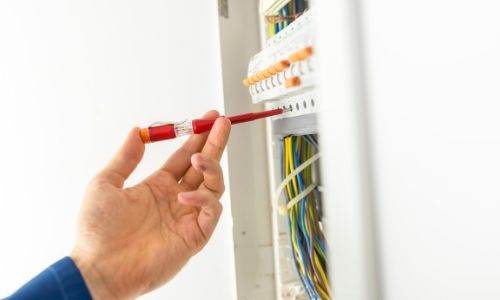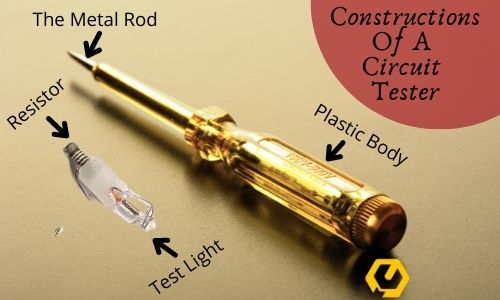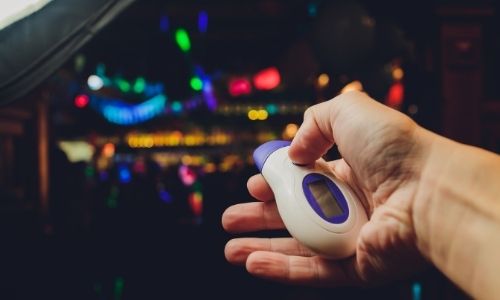An electrician and DIYers use circuit tester to check electrical functions. In case you’re wondering how does circuit tester work, we made it simple for you!
A circuit tester is a handy dandy tool for all kinds of electrical functions. People who design their own homes find this tool very useful to check the wiring. There are many types of testers and one might be an expert identifying the varieties. However, it’d be great to know how it works.
So, how does a circuit tester work?
The basic function of the tester is simple. When you attach the two leads of the tester to the wires or to an electric socket, the little neon bulb in the tester lights up. This means the circuit of the socket is complete and properly wired. When the metallic tip touches the conductors, the tester completes the circuit by using the capacitance in the tester. The flow of voltage from the sockets to the tester lights up the neon bulb.
This is just an overview of how circuit testers functions. If you want to know further how a circuit tester works, their variety, and their purpose, spare a minute and read this article.
Related Reads: Do you Know About What Size Screwdrivers Do Electricians Need?
Let’s dive in-
How Does Circuit Tester Work And Why We Need It
All homeowners should own a tester. Be it for your car or for electric sockets, you can’t tell when you’ll be needing one. So, before we jump to the function of circuit testers, let us first know some basics about this important tool.
What Is A Circuit Tester?

There are many types of electric testers to measure the voltage, current, continuity, and resistors. And circuit tester is one of them.
A circuit tester is a device that measures the flow of electricity of open-wire or electric circuits. It also measures the absence and presence of voltage at any point of the circuit wires. It basically tells you if a circuit is working or not. We often need a circuit tester to test ground wires. Also, the tester informs us if a circuit is good or not. So, it’s ideal to buy a circuit tester that is rated for up to 500 voltage source.
Another interesting fact about circuit testers is that these tools don’t need any batteries to run. Even if you have a voltage stick, you can keep the circuit tester as a back. Because it will come in handy once the battery of other testers runs out.
Here’s a list of circuit testers that we think will help you find the good wirings in your house-
A circuit tester is also called a receptacle tester or an outlet tester.
Constructions Of A Circuit Tester
Now that we know what a circuit tester is let us find out how it’s constructed. The constructions and the integral parts of the tester are important because they’ll help you find out the function of the tester. Knowing the construction also helps the diyers.
In a typical circuit tester, there are mainly four parts that we need to know about. In this article, we’ll be discussing these four parts.

The Metal Rod
A two-lead circuit tester consists of two wires. These two wires have a cylindrical metal screwdriver/rod/probe at the terminal. This is the part that is attached to an outlet/wire/switch. Some probes run with a battery. The current flows through these metal leads to the light bulb and resistors within.
Plastic Body
The resistance, neon light bulb, and the wires from the metal leads are covered by a plastic insulated body. The wires from the meatal leads are also in the plastic body.
Resistor
A resistor opposes the amount of current flow. Using a tester without a resistor is dangerous. The reason is that without the resistor the current flowing through the wires could break the neon light bulb/test lights. A resistor in-circuit testers is placed between the neon light bulb and the metal wires. This way high current cannot reach the test lamp.
Test Light
This is the most crucial part of a circuit test. Test lights are the only indicator of a complete circuit. And it doesn’t require a lot of currents to light up the bulb. That’s why tester with light bulbs are more reliable.
Now that you know the details about the tester, let us take a look at how it’s used-
How to Use A Circuit Tester On An Outlet/Switch
Circuit testers are a must-have. And if you have one, you must know the proper way to use it. Don’t worry, using a wiring tester is the safest way to find out if a circuit is complete or not. And it’s super easy. So you don’t have to waste a sec of your precious time.
Before we jump into the steps, here’s what you’ll need-
Tools Need:
• Screwdriver
• Circuit/Wiring Tester
• Voltage Tester
Now here’s a step by step guide on how to use circuit testers–
Step 1
The first thing that you would have to do is to separate the wires from the switch. Or open the outlet/electric socket/electric switch with a screwdriver. After opening the outlet you’ll be able to see the wires. Separate the wires very carefully. And make sure the wires don’t contact each other.
Step 2
For this step, you’ll need to know how to use a voltage tester screwdriver. Because using the voltage tester you’ll have to identify the hot wire and the neutral wire of the sockets. You can also use a non-contact voltage tester or voltage stick because it’s easy and quick. But make sure the battery of the voltage stick has not run out.
We recommend using any of the non-contact voltage tester from our curated list-
We hope this information has helped you identify the hot wire (VERY CAREFULLY!). Now, you can proceed to the next step.
Step 3
In this step, you’ll need the circuit/wiring tester. Attach one metal lead of the tester to the hot wire and the other metal lead or metal probe/metal tip to the neutral wire. After attaching the metal leads with the wire, check the neon light of the tester. If it lights up, then you have nothing to worry about. Your circuit is complete and the wiring is A-okay.
The next step is to check the ground connection.
Step 4
You can proceed with step 4 only if you want to check your ground wire. In order to check the ground wire, you’ll need to attach one metal lead to the hotwire and the other to the ground wire/grounding slot. If the bulb lights up then you can be sure that your circuit is properly grounded.

Caution
While working with the wires, you need to keep this information in mind-
• Make sure you don’t touch the metal leads/probes when they are connected with wires.
• Keep away from the hot wire while using a voltage tester.
• Do not let the hot wire come in contact with anything else.
Just like we promised, using the circuit/wiring tester is simple and will not take much of your time. What’s more interesting, the mechanism of a tester is easier than using it.
No, the function of a circuit/wiring tester is not rocket science at all.
How Does A Circuit Tester Function
By now, we hope you’ll be able to use circuit testers. The process of the tester is even more interesting.
There are many kinds of electrical tester screwdrivers. Some of which detects voltage, some measure the amount of current and some measure the amount of resistance. However, among all the other electric testers, a circuit/wiring tester is the most reliable and safest way to find out the current flow of a circuit.
When metal probes/metal tip are connected to the hot and ground wire, current flows from one lead to the other. This current flows through the resistor and the neon light bulb. Neon indicator lights don’t require much voltage. It only takes a little amount of voltage, in most cases 100V to light up the neon test lamp.
So if the light bulb of the tester lights up then the circuit is in perfect condition. You don’t have to fret about it anymore.
Another important of data about these tool, the resistor in the tester is also a hero in this case. Because it reduces the amount of current passing through the wires. This converts the high current to a suitable amount for the test light bulb. Otherwise, the test light bulb may get damaged.
In this way, a current running through the circuit/wiring tester can help you identify the functional circuits of your home.
Why Do We Need Circuit/wiring Tester?
If I answer simply, we need circuit testers for home wiring.
Suppose you’ve moved to a new home, and you want to figure out if all the circuits are grounded or not. Whether all the sockets are functional. In this case, the only way to check the circuits is by testing with circuit testers. Using the tester, we will be able to find out if there are any wiring errors.
Again, if you have designed your own home, you’ll need a tester to find out if all the circuits are fine and in working conditions.
Moreover, you can test all your circuits to check if they are grounded properly or not.
Aren’t circuit testers lifesavers?
People Also Ask About Circuit Tester

How does an electric tester work?
There are many types of electric testers. The measure the resistance, the continuity, the voltage, and current flow. The electric tester works by attaching the metal lead to a socket. If the test light of the tester lights up, then you’re circuit is doing fine.
What is a circuit/wiring tester and how does it work?
A circuit tester/wiring is a device that is used to check the current flow of a circuit. It basically checks if the power source is complete or not. This electric tester works by connecting the socket wires to the metal lead/probe of the tester. This way the current flows from the socket tester and back to the socket again. Allowing the circuit to be complete.
How do you use a simple circuit tester?
Take the metal leads of the circuit and attach one with the hot wire and the other with the neutral wire. You might have to use a voltage tester for identifying the wires. If the current flows through them then the test light will turn on. If it doesn’t then the circuit will need some repair.
Conclusion
We hope you’ve become a circuit/wiring tester expert by now. Because along with using the testers you also know how does circuit tester work. Make sure you take every step of precautions needed to operate the testers and deal with running voltage.
Circuit Testers will save your life by identifying all your well-connected wirings. So let us know which tester you’re going for and your experience of using this important tool.
Have a great day!
